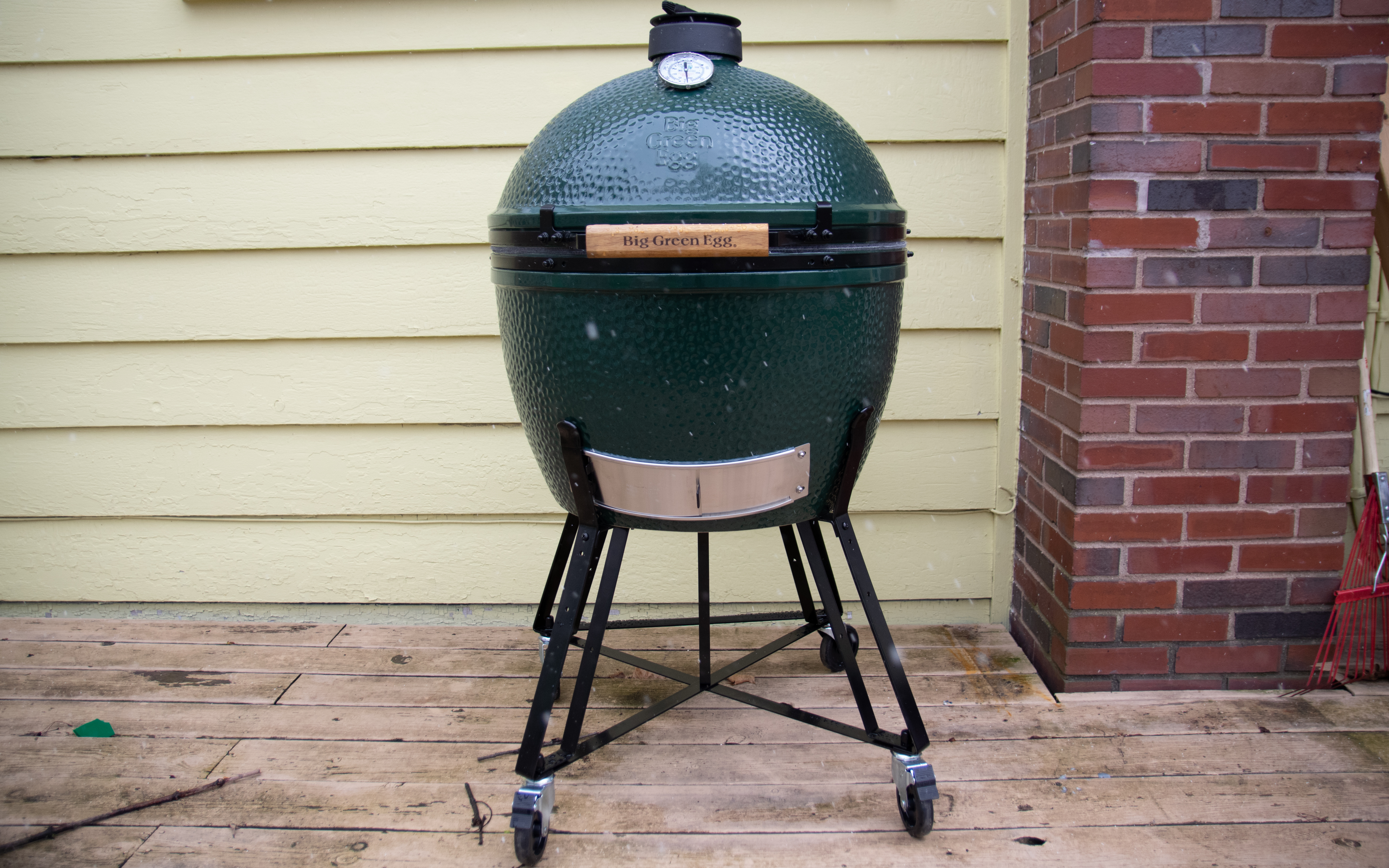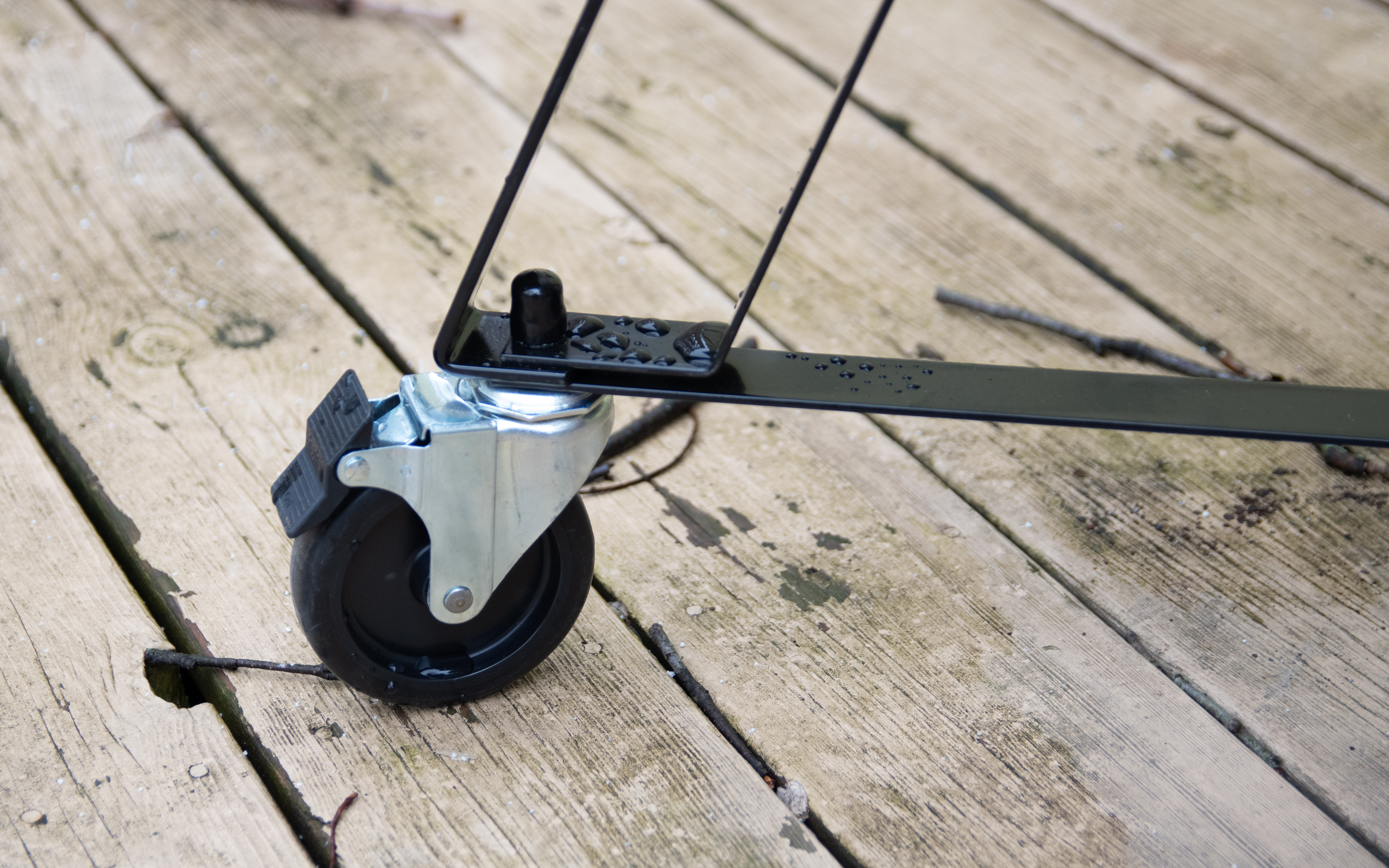Big Green Egg Table: Design 1
After our Good Friday Fish Fry / Bridal Shower was canceled due to the COVID-19 shelter-in-place guidelines, Melissa and I were recently gifted an XL Big Green Egg by all my aunts and uncles on my mom’s side. A couple of guys from Big George’s delivered the Egg and set it up on our deck without coming into contact with us. It’s a very beautiful cooker that weighs just over 200 lbs. To bring it up to comfortable cooking height, it arrived with an EGG Nest, a fabricated metal pedestal on casters.

I have a few problems with the Nest:
- The fragile Egg can easily be tipped over
- The wooden deck below the Egg has no protection from heat
- There are no work surfaces next to the grill and no storage for accessories
- The casters are not great

Being a hobbyist woodworker, I naturally want to build my own replacement for the EGG Nest. In this post I will examine some of the existing designs floating around on the Internet before creating my own set of plans which meet my criteria.
Commercial Nest Alternatives
There are lots of commercial alternatives to the EGG Nest, such as as the Modular Nest EGG Frame or the 76 inch Custom Cooking Island. However, these are in my opinion far too expensive.
Also available from Big Green Egg is the Acacia Hardwood Table which is what my dad has been using for fifteen years with his egg.
Wooden tables are also available from third party manufacturers such as JJGeorge and J S Designs Shop which are of a similar design to the original BGE table.
DIY Tables
There are countless examples of DIY wooden tables for the Big Green Egg on the
Internet. For example, the top Google search result for diy big green egg table will lead you to Seared and Smoked
which has a video and
plans for their
design.
Some other random examples I’ve found:
- Andys Werkstatt
- Bellman Woodworking And Designs
- BigMeat Sunday
- Dogwood Nation
- Luke Marazzi
- My Outdoor Plans
- Seared and Smoked
- Smoke & Hammer
- unoriginalusername
All these examples so far share a common design decision: they don’t use any joinery. Instead of designing the structures using wood joints which have been proven to last for hundreds of years, they rely purely on the strength of the fasteners used to screw the wood together.
The commercially designed tables likely are made in this manner to make them easy to ship and assemble. If large diameter bolts are used to fix the Egg platform to the legs, the table will likely be solid and last quite a long time. However, if you use regular screws to simply screw the platform to the legs as seen in most DIY plans available online, you will be relying on the shear strength of the screws.
A common wood screw is very good at squeezing two boards together along its
axis. The withdrawl or pullout force of a screw is relatively high. However,
screws are not very good at resisting shear forces perpendicular to their
axis. You can read more about the differences between shear and pullout
strength at Builder
Online
or simply use a search engine with keywords shear strength of screws.
To make matters worse, even the best metal hardware will deteriorate over time due to the elements. I can’t think of a worse way to wake up in fifteen years than the sound of ceramic crashing to the ground due to failed wood screws!
Don’t get me wrong - I don’t intend to call anybody out or suggest that these tables won’t be up to their intended task. On the contrary, most of these tables will likely hold up fine for many years. However, using different woodworking techniques we can create furniture which lasts for centuries, not decades.
Well-designed Tables
I have been able to find some examples of DIYers who have used some proper joinery. The commonality here is that the weight of the cooker is supported by wood, not by fasteners. In all these designs the smoker would still be well supported if the fasteners were removed and the structures were not subjected to any racking forces.
Mortise and Tenon Joints
The Mortise and Tenon joint is the mack daddy of frame construction. A hole, or mortise, is cut in one piece and a matching insert, or tenon, is cut in the end of the piece to be joined to it. The tenon is inserted into the mortise and fixed using glue, wedges, or drawboring.
Carter Rosenbloom has put together a beautiful Big Green Egg table built with mortise and tenon joints.
DustyMark also has some end result photos of his mahogany table which was assembled with mortise and tenon joints.
mteele on the EGGhead forum also posted some PDF plans and photos of his gorgeous Ipe wood table using M&T joints. I’d be a little concerned with the breadboard ends; depending on how they were glued up the table top could eventually split due to the wood movement of the long table pieces.
Lap Joints
A Lap Joint is another great joint for use in frame construction. In a lap joint, material is removed from one or both pieces where they cross or overlap. This joint ensures a lot of long-grain surface area meets for a very strong glue up. It doesn’t have the same resistance to glue failure as a mortise and tenon joint, but with modern glues like Titebond III this really isn’t a problem.
jessemckee of Instructables has written some free plans for a very nice and simple table using lap joints. I think he really nailed it with this project!
In my next post, I’ll explore some of my own design criteria and work out some initial plans.